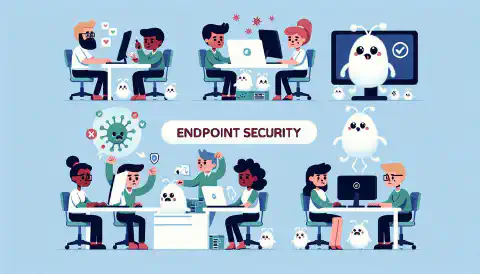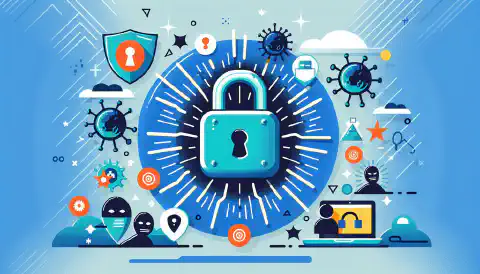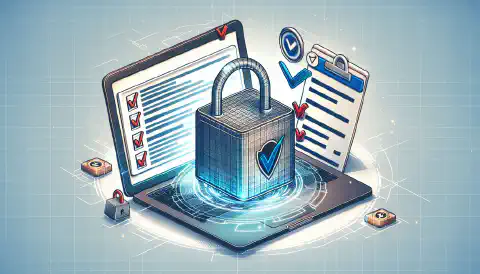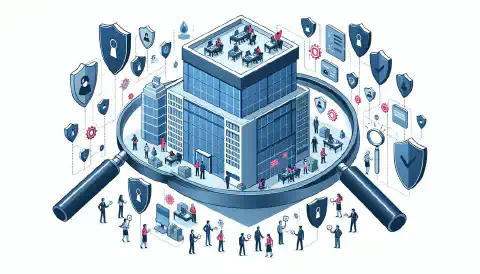Mastering Security Automation: Strategies, Tools, and Metrics for Cyber Resilience

Table of Contents
Deep Dive into Security Automation: Strategies and Implementation
In today’s fast-paced digital landscape, security automation has become a critical component of an organization’s cybersecurity strategy. As threats evolve and become more sophisticated, the need for efficient and effective security automation is paramount. This article delves into the strategies and implementation of security automation, exploring its benefits, challenges, best practices, frameworks, tools, technologies, and the measurement of its effectiveness.
Key Takeaways
- Security automation enhances threat detection and response capabilities.
- Choosing the right automation framework is crucial for successful implementation.
- Integration with existing systems requires careful planning and consideration.
- Machine learning and AI play a significant role in advancing security automation.
- Measuring KPIs and continuous improvement are essential for evaluating the effectiveness of security automation.
Understanding Security Automation
Benefits of Security Automation
Security automation offers significant advantages for organizations looking to enhance their security posture. By automating routine security tasks, organizations can improve efficiency and reduce human error. This leads to faster response times and enhanced threat detection. Additionally, security automation enables consistency in security processes and streamlines compliance efforts. Organizations can also benefit from cost savings and resource optimization through the implementation of security automation.
- Improved efficiency
- Reduced human error
- Faster response times
- Enhanced threat detection
- Consistency in security processes
- Streamlined compliance efforts
- Cost savings
- Resource optimization
Tip: When implementing security automation, it’s essential to carefully evaluate the processes and tasks that can be automated to maximize the benefits and minimize potential risks.
Challenges in Implementing Security Automation
Implementing security automation can be challenging, but overcoming these challenges is crucial for enhancing cybersecurity. It requires careful planning, resource allocation, and a deep understanding of the organization’s security posture.
- Lack of skilled personnel and expertise in automation technologies
- Resistance to change and cultural barriers within the organization
- Integration complexities with legacy systems and diverse security tools
- Balancing automation with human intervention for critical decision-making
Tip: Establish a clear roadmap for automation adoption and communicate the benefits to all stakeholders. This will help in gaining support and alignment across the organization.
Best Practices for Security Automation
Automating security processes offers numerous benefits, including efficiency, consistency, and scalability. However, implementing security automation also presents challenges such as integration complexity, skill gaps, and resistance to change. To ensure successful implementation, consider the following best practices:
Collaboration: Foster collaboration between security, IT, and development teams to align automation efforts with business goals.
Continuous Improvement: Establish a culture of continuous improvement by regularly reviewing and updating automation processes.
Training and Skill Development: Invest in training and skill development to address the skill gaps and ensure the effective use of automation tools.
Compliance and Governance: Integrate compliance and governance requirements into the automation framework to maintain regulatory adherence.
Testing and Validation: Implement rigorous testing and validation processes to ensure the reliability and accuracy of automated security controls.
Tip: Prioritize the automation of repetitive, time-consuming tasks to maximize the impact of security automation.
Implementing Security Automation Frameworks
Choosing the Right Framework
When choosing the right framework for security automation, it’s essential to consider the specific requirements of your organization. Customization and configuration capabilities are crucial for aligning the framework with your existing security infrastructure.
Additionally, evaluating the integration with existing systems is vital to ensure seamless deployment and operation. This involves assessing compatibility with various security tools, network architecture, and data sources.
A structured comparison table can aid in the decision-making process, outlining key features, scalability, and support for industry standards. Consider including factors such as cost, support, and community engagement to make an informed choice.
Tip: Engage with stakeholders from different teams to gather diverse perspectives and requirements, ensuring the selected framework meets the needs of various stakeholders.
Integration with Existing Systems
When integrating security automation frameworks with existing systems, it’s crucial to ensure seamless connectivity and interoperability. This involves assessing the compatibility of the framework with the organization’s infrastructure and identifying potential points of integration.
Consider creating a table to compare the features and requirements of the chosen framework with the existing systems. This will provide a clear overview of the integration process and help in identifying any gaps or conflicts that need to be addressed.
Ensure that the integration process does not disrupt the normal functioning of existing systems. It’s essential to conduct thorough testing and validation to minimize the risk of disruption or downtime.
Leverage the use of APIs and webhooks for seamless integration. These tools enable the exchange of data and events between systems, facilitating smooth communication and interaction.
Tip: Prioritize the establishment of clear communication channels between the security automation framework and existing systems to ensure efficient data exchange and coordination.
Customization and Configuration
When it comes to customization and configuration of security automation frameworks, it’s crucial to tailor the solution to the specific needs of the organization. This involves adapting the framework to align with the existing security infrastructure and processes. Flexibility and scalability are key considerations to ensure seamless integration and future-proofing. Additionally, the ability to accommodate dynamic threat landscapes and evolving compliance requirements is essential for long-term success. A well-defined customization strategy enables organizations to optimize the use of automation tools and technologies, maximizing their effectiveness in addressing complex security challenges .
Security Automation Tools and Technologies
Automation Orchestration Platforms
Automation orchestration platforms play a crucial role in streamlining and coordinating security automation processes. These platforms enable the integration of various security tools and technologies, facilitating seamless communication and workflow orchestration. They provide a centralized dashboard for monitoring and managing security automation tasks, ensuring efficient incident response and remediation.
Key features of automation orchestration platforms:
| Feature | Description |
|---|---|
| Centralized Dashboard | Provides a unified view of security automation tasks and workflows. |
| Workflow Orchestration | Coordinates the execution of security automation processes across different tools and systems. |
| Integration with Security Tools | Enables seamless integration with a wide range of security tools and technologies. |
| Incident Response Automation | Facilitates rapid and automated response to security incidents, minimizing manual intervention. |
- When selecting an automation orchestration platform, consider the scalability, flexibility, and compatibility with existing security infrastructure.
- Ensure that the platform supports integration with a variety of security tools and technologies.
- Regularly assess the platform’s performance and adaptability to evolving security requirements.
Machine Learning and AI in Security Automation
Machine Learning and AI play a crucial role in enhancing security automation by leveraging advanced algorithms and intelligent decision-making processes. These technologies enable automated threat detection and behavioral analysis, empowering security systems to adapt and respond to evolving threats.
By harnessing machine learning models, security automation can identify patterns and anomalies in large datasets, leading to more accurate threat detection and proactive risk mitigation. Additionally, AI-driven automation facilitates adaptive security measures that can dynamically adjust to new attack vectors and vulnerabilities.
Table: Machine Learning and AI Benefits
| Benefits | Description |
|---|---|
| Enhanced threat detection | Utilizes advanced algorithms to identify and respond to sophisticated threats. |
| Behavioral analysis | Analyzes user behavior and network activities to detect anomalies and potential security risks. |
Tip: Implementing machine learning and AI in security automation requires a deep understanding of the organization’s security landscape and a strategic approach to integration.
Machine learning and AI are pivotal in the evolution of security automation, offering unparalleled capabilities to fortify defenses and proactively safeguard against emerging cyber threats.
Open Source vs. Commercial Tools
Open Source vs. Commercial Tools
When considering security automation tools and technologies, one crucial decision is choosing between open source and commercial tools. Each option comes with its own set of advantages and limitations.
Open source tools offer flexibility and customization, making them ideal for organizations with specific requirements. However, they may require more in-house expertise for maintenance and support.
On the other hand, commercial tools often provide comprehensive support, regular updates, and integration with other security solutions. They are suitable for organizations seeking a more streamlined and standardized approach to security automation.
It’s essential to carefully evaluate the cost, features, and support offered by both open source and commercial tools to align with the organization’s security automation goals and resources.
- Consider the long-term sustainability of open source tools, including community support and development activity.
- Evaluate the total cost of ownership (TCO) for commercial tools, factoring in licensing, maintenance, and scalability.
- Seek input from security experts and peers to gain insights into their experiences with different tool types and their suitability for specific use cases.
Measuring the Effectiveness of Security Automation
Key Performance Indicators (KPIs)
Key Performance Indicators (KPIs) are essential metrics used to evaluate the success of security automation initiatives. They provide valuable insights into the performance and impact of security automation on the overall security posture of an organization. KPIs help in monitoring the efficiency of automated security processes and identifying areas for improvement.
- Number of security incidents detected and resolved: This KPI measures the effectiveness of security automation in identifying and mitigating security incidents in a timely manner.
- Reduction in mean time to detect (MTTD) and mean time to respond (MTTR): Tracking the reduction in MTTD and MTTR through security automation reflects the improvement in incident response efficiency.
- Percentage of security alerts handled automatically: This KPI indicates the extent to which security automation is capable of autonomously handling security alerts without human intervention.
Tip: Regularly review and update the KPIs to align with evolving security threats and organizational objectives. This ensures that the measurement of security automation effectiveness remains relevant and impactful.
Incident Response and Remediation
Incident Response and Remediation
Measuring the effectiveness of security automation is crucial for ensuring that the implemented solutions are providing the intended benefits. It involves tracking key performance indicators (KPIs), evaluating the efficiency of incident response and remediation, and continuously striving for continuous improvement and adaptation.
Key Performance Indicators (KPIs) play a vital role in assessing the impact of security automation. They include metrics such as detection time, response time, and incident resolution time.
Incident response and remediation processes should be closely monitored to identify areas for improvement. This includes analyzing the effectiveness of automated response actions and the accuracy of automated remediation.
Tip: Regularly review and update KPIs to align with evolving security threats and organizational goals.
Continuous improvement and adaptation are essential for maintaining the effectiveness of security automation. This involves leveraging insights from incident response data to refine automation processes and ensure they remain aligned with the evolving threat landscape.
Continuous Improvement and Adaptation
Continuous Improvement and Adaptation
Measuring the effectiveness of security automation is crucial for ensuring that the implemented strategies are delivering the intended outcomes. It involves tracking and analyzing key performance indicators (KPIs), incident response and remediation, and continuous improvement and adaptation. This process enables organizations to assess the impact of security automation on their overall security posture and make informed decisions for further enhancements.
- Key Performance Indicators (KPIs) play a vital role in quantifying the success of security automation. These metrics may include reduction in mean time to detect (MTTD) and mean time to respond (MTTR), increase in threat detection accuracy, and improvement in overall incident response efficiency.
- Incident response and remediation are essential aspects of measuring effectiveness. Analyzing the speed and effectiveness of automated incident response, as well as the accuracy of remediation actions, provides valuable insights into the efficiency of security automation.
- Continuous improvement and adaptation are ongoing processes that require regular evaluation. Organizations should continuously assess the effectiveness of security automation, identify areas for improvement, and adapt their strategies to evolving threats and vulnerabilities.
Tip: Regularly review and update the KPIs to align with changing security priorities and business objectives. This ensures that the measurement of security automation effectiveness remains relevant and actionable.
Conclusion
In conclusion, security automation is a critical component of modern cybersecurity strategies. By understanding the benefits and challenges of security automation, organizations can implement best practices to enhance their security posture. Choosing the right framework and effectively integrating it with existing systems is essential for successful implementation. Additionally, leveraging automation orchestration platforms, machine learning, and AI can significantly improve the efficiency and effectiveness of security automation. Measuring the effectiveness of security automation through key performance indicators, incident response, and continuous improvement is vital for ensuring a robust security infrastructure. As organizations continue to adapt to evolving threats and vulnerabilities, security automation will play a pivotal role in safeguarding digital assets and mitigating risks.
Frequently Asked Questions
What are the primary benefits of security automation?
The primary benefits of security automation include improved efficiency, reduced human error, faster response to security incidents, and better resource allocation.
What are the common challenges in implementing security automation?
Common challenges in implementing security automation include integration with existing systems, resistance to change, lack of skilled personnel, and ensuring the accuracy and reliability of automated processes.
What are the best practices for implementing security automation?
Best practices for implementing security automation include conducting thorough risk assessments, establishing clear objectives, involving key stakeholders, and continuously monitoring and updating the automation processes.
How do I choose the right security automation framework?
When choosing a security automation framework, consider factors such as scalability, compatibility with existing tools, support for industry standards, and the specific security needs of your organization.
What role does machine learning and AI play in security automation?
Machine learning and AI enable security automation to analyze large volumes of data, detect patterns, and make intelligent decisions to identify and respond to security threats in real time.
What are the key differences between open source and commercial security automation tools?
Open source security automation tools are often freely available and customizable, while commercial tools offer dedicated support, advanced features, and integration with other security solutions.






